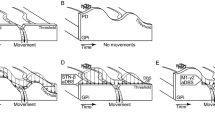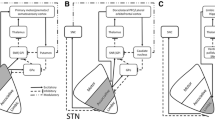Abstract
The subthalamic nucleus (STN) is an important component of the basal ganglia (BG) and plays a major role in the pathogenesis of Parkinson’s disease (PD). Hyperactivity of STN as a consequence of the loss of dopaminergic inputs to the BG is believed to be a major factor in producing the motor symptoms of PD. High-frequency (HF) deep brain stimulation (DBS) of the STN has recently become an important treatment in PD patients where medications no longer provide satisfactory therapy. However, the mechanisms underlying DBS therapy are unknown, and there is seemingly conflicting data suggesting inhibition or excitation of STN neurons. This study directly examined the effects of stimulation in STN on the activity of STN neurons in PD patients during functional stereotactic mapping prior to insertion of DBS electrodes. Electrical stimulation in STN was investigated in twelve PD patients by recording the neural activity of a cell in STN with one electrode while applying current pulses through a second electrode located about 600 µm away. Stimulation at high frequencies (100–300 Hz) was found to produce inhibition following the stimulus train in 42% of the 60 cells tested. Inhibition during the train was seen in 13 of 15 neurons where it was possible to detect such activity. Furthermore, in 44% of the cases where HF stimulation produced inhibition there was an early inhibition followed by rebound excitation and a further inhibitory period, suggesting that the inhibitions observed are due to hyperpolarization. In eight of the 25 neurons inhibited by HF stimulation, the effects of single stimuli were determined and revealed that in seven of these there was an inhibitory period of 15–20 ms following each stimulus. Thus, the present findings suggest that local HF stimulation inhibits many STN neurons. However, these studies could not determine whether the stimulus also directly excited the cell and/or its axon, but other recent findings suggest that this is likely the case. Therefore, the overall effects of DBS stimulation in STN are likely to be inhibition of intrinsic and synaptically mediated activity, and its replacement by regular high-frequency firing.





Similar content being viewed by others
References
Albin RL (1995) The pathophysiology of chorea/ballism and parkinsonism. Parkinsonism Rel Disorders 1:3–11
Albin RL, Young AB, Penney JB (1989) The functional anatomy of basal ganglia disorders. Trends Neurosci 12:366–375
Anderson ME, Postupna N, Ruffo M (2003) Effects of high-frequency stimulation in the internal globus pallidus on the activity of thalamic neurons in the awake monkey. J Neurophysiol 89:1150–1160
Aziz TZ, Peggs D, Sambrook MA, Crossman AR (1991) Lesion of the subthalamic nucleus for the alleviation of 1-methyl-4-phenyl-1,2,3,6-tetrahydropyridine (MPTP)-induced parkinsonism in the primate. Mov Dis 6:288–292
Benabid AL, Pollak P, Gross C, Hoffmann D, Benazzouz A, Gao DM, Laurent A, Gentil M, Perret JE (1994) Acute and long-term effects of subthalamic nucleus stimulation in Parkinson’s disease. Stereotact Funct Neurosurg 62:76–84
Benazzouz A, Piallat B, Pollak P, Benabid AL (1995) Responses of substantia nigra pars reticulata and globus pallidus complex to high frequency stimulation of the subthalamic nucleus in rats: electrophysiological data. Neurosci Lett 189:77–80
Benazzouz A, Gao DM, Ni ZG, Piallat B, Bouali-Benazzouz R, Benabid AL (2000) Effect of high-frequency stimulation of the subthalamic nucleus on the neuronal activities of the substantia nigra pars reticulata and ventrolateral nucleus of the thalamus in the rat. Neuroscience 99:289–295
Bergman H, Wichmann T, DeLong MR (1990) Reversal of experimental parkinsonism by lesions of the subthalamic nucleus. Science 249:1436–1438
Beurrier C, Bioulac B, Hammond C (2000) Slowly inactivating sodium current (I(NaP)) underlies single-spike activity in rat subthalamic neurons. J Neurophysiol 83:1951–1957
Beurrier C, Bioulac B, Audin J, Hammond C (2001) High-frequency stimulation produces a transient blockade of voltage-gated currents in subthalamic neurons. J Neurophysiol 85:1351–1356
Bevan MD, Wilson CJ (1999) Mechanisms underlying spontaneous oscillation and rhythmic firing in rat subthalamic neurons. J Neurosci 19:7617–7628
Bevan MD, Wilson CJ, Bolam JP, Magill PJ (2000) Equilibrium potential of GABA(A) current and implications for rebound burst firing in rat subthalamic neurons in vitro. J Neurophysiol 83:3169–3172
Bikson M, Lian J, Hahn PJ, Stacey WC, Sciortino C, Durand DM (2001) Suppression of epileptiform activity by high frequency sinusoidal fields in rat hippocampal slices. J Physiol 531:181–191
Burbaud P, Gross C, Bioulac B (1994) Effect of subthalamic high frequency stimulation on substantia nigra pars reticulata and globus pallidus neurons in normal rats. J Physiol (Paris) 88:359–361
DeLong MR (1990) Primate models of movement disorders of basal ganglia origin. Trends Neurosci 13:281–285
Dostrovsky JO, Levy R, Wu JP, Hutchison WD, Tasker RR, Lozano AM (2000) Microstimulation-induced inhibition of neuronal firing in human globus pallidus. J Neurophysiol 84:570–574
Dostrovsky JO, Filali M, Hutchison WD, Lozano AM (2001) Inhibition of substantia nigra pars reticulata (SNr) neurons by electrical stimulation. Soc Neurosci Abstr 27: Prog. No. 827.14
Garcia L, Audin J, D’Alessandro G, Bioulac B, Hammond C (2003) Dual effect of high-frequency stimulation on subthalamic neuron activity. J Neurosci 23:8743–8751
Gill SS, Heywood P (1997) Bilateral dorsolateral subthalamotomy for advanced Parkinson’s disease. Lancet 350:1224
Hashimoto T, Elder CM, Okun MS, Patrick SK, Vitek JL (2003) Stimulation of the subthalamic nucleus changes the firing pattern of pallidal neurons. J Neurosci 23:1916–1923
Hershey T, Revilla FJ, Wernle AR, McGee-Minnich L, Antenor JV, Videen TO, Dowling JL, Mink JW, Perlmutter JS (2003) Cortical and subcortical blood flow effects of subthalamic nucleus stimulation in PD. Neurology 61:816–821
Hutchison WD, Allan RJ, Opitz H, Levy R, Dostrovsky JO, Lang AE, Lozano AM (1998) Neurophysiological identification of the subthalamic nucleus in surgery for Parkinson’s disease. Ann Neurol 44:622–628
Hutchison WD, Lang AE, Dostrovsky JO, Lozano AM (2003) Pallidal neuronal activity: implications for models of dystonia. Ann Neurol 53:480–488
Jech R, Urgosik D, Tintera J, Nebuzelsky A, Krasensky J, Liscak R, Roth J, Ruzicka E (2001) Functional magnetic resonance imaging during deep brain stimulation: a pilot study in four patients with Parkinson’s disease. Mov Disord 16:1126–1132
Kumar R, Lozano AM, Kim YJ, Hutchison WD, Sime E, Halket E, Lang AE (1998) Double-blind evaluation of subthalamic nucleus deep brain stimulation in advanced Parkinson’s disease. Neurology 51:850–855
Levy R, Lang AE, Dostrovsky JO, Pahapill P, Romas J, Saint-Cyr J, Hutchison WD, Lozano AM (2001) Lidocaine and muscimol microinjections in subthalamic nucleus reverse Parkinsonian symptoms. Brain 124:2105–2118
Limousin P, Pollak P, Benazzouz A, Hoffmann D, Le Bas JF, Broussolle E, Perret JE, Benabid AL (1995) Effect on parkinsonian signs and symptoms of bilateral subthalamic nucleus stimulation. Lancet 345:91–95
Lozano AM, Hutchison WD, Kiss ZHT, Davis KD, Dostrovsky JO (1996) Methods for microelectrode-guided posteroventral pallidotomy. J Neurosurg 84:194–202
Magarinos-Ascone C, Pazo JH, Macadar O, Buno W (2002) High-frequency stimulation of the subthalamic nucleus silences subthalamic neurons: a possible cellular mechanism in Parkinson’s disease. Neuroscience 115:1109–1117
McIntyre CC, Grill WM (2002) Extracellular stimulation of central neurons: influence of stimulus waveform and frequency on neuronal output. J Neurophysiol 88:1592–1604
Miller WC, DeLong MR (1989) Parkinsonian symptomatology. An anatomical and physiological analysis. Ann NY Acad Science 515:287–302
Parent A, Smith Y (1987) Organization of efferent projections of the subthalamic nucleus in the squirrel monkey as revealed by retrograde labeling methods. Brain Res 436:296–310
Ranck JB (1975) Which elements are excited in electrical stimulation of mammalian central nervous system: a review. Brain Res 98:417–440
Sato F, Parent M, Levesque M, Parent A (2000) Axonal branching pattern of neurons of the subthalamic nucleus in primates. J Comp Neurol 424:142–152
Tai CH, Boraud T, Bezard E, Bioulac B, Gross C, Benazzouz A (2003) Electrophysiological and metabolic evidence that high-frequency stimulation of the subthalamic nucleus bridles neuronal activity in the subthalamic nucleus and the substantia nigra reticulata. FASEB J 17:1820–1830
Tang J, Lozano AM, Lang AE, Hutchison WD, Dostrovsky JO (2003) Firing rates of pallidal neurons are similar in Huntington’s and Parkinson’s disease patients. Soc Neurosci Abstracts 390.1
Wichmann T, Bergman H, DeLong MR (1994) The primate subthalamic nucleus. III. Changes in motor behavior and neuronal activity in the internal pallidum induced by subthalamic inactivation in the MPTP model of parkinsonism. J Neurophysiol 72:521–530
Windels F, Bruet N, Poupard A, Urbain N, Chouvet G, Feuerstein C, Savasta M (2000) Effects of high frequency stimulation of subthalamic nucleus on extracellular glutamate and GABA in substantia nigra and globus pallidus in the normal rat. Eur J Neurosci 12:4141–4146
Wu YR, Levy R, Ashby P, Tasker RR, Dostrovsky JO (2001) Does stimulation of the GPi control dyskinesia by activating inhibitory axons? Mov Disord 16:208–216
Acknowledgements
We wish to thank Helen Belina for expert assistance with the figures. Funding was provided by the U.S. National Institutes of Health (NS 40872) and Canadian Institutes of Health Research (MOP-42505). AML is a Canadian Institutes of Health Research clinician scientist.
Author information
Authors and Affiliations
Corresponding author
Rights and permissions
About this article
Cite this article
Filali, M., Hutchison, W.D., Palter, V.N. et al. Stimulation-induced inhibition of neuronal firing in human subthalamic nucleus. Exp Brain Res 156, 274–281 (2004). https://doi.org/10.1007/s00221-003-1784-y
Received:
Accepted:
Published:
Issue Date:
DOI: https://doi.org/10.1007/s00221-003-1784-y




